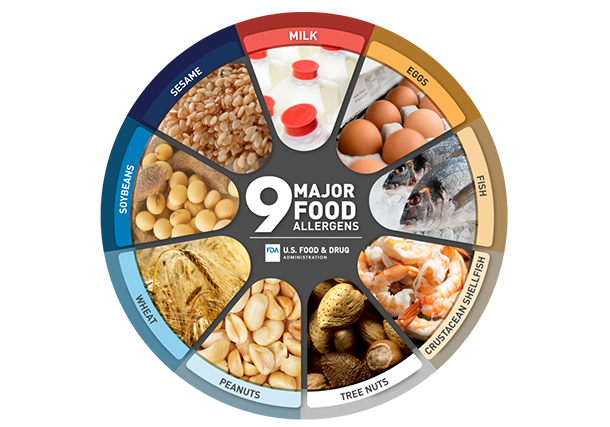
Food Allergy Treatment in Charlotte
Food allergies can be a frustrating and even life-threatening condition for many individuals. Even mild symptoms, such as hives or itchiness of the mouth, can be uncomfortable and interfere with daily life. Managing and avoiding your food allergy while maintaining your normal lifestyle can be difficult, but at Carolina Asthma & Allergy Center, we understand the impact that food allergies can have on your health and well-being. We are committed to providing comprehensive care to help manage and treat this condition.
Our team of board-certified allergists and experienced healthcare professionals is dedicated to providing personalized treatment plans and ongoing support to help you live your life to the fullest. Whether you are seeking a diagnosis, treatment, or ongoing management of your food allergies, we are here to help you every step of the way.
How to Request an Appointment
At Carolina Asthma and Allergy Center, we offer comprehensive evaluation and treatment for food allergies. If you suspect you may have a food allergy due to the presence of a food allergy in the family or symptoms that seem to occur after exposure to certain foods, you can request an appointment with our team of board-certified allergists and experienced healthcare professionals.
To schedule an appointment, you can call our office or fill out the online appointment request form on our website. Our friendly staff will work with you to find a convenient date and time for your visit.
During your appointment, our allergists will review your medical history, perform a physical exam, and conduct any necessary tests to determine if you have a food allergy. Based on your evaluation, our team will develop a personalized treatment plan to help manage your symptoms and prevent future allergic reactions.
What are Food Allergies?
An allergy refers to an immune system reaction that is unnecessary. These reactions can occur in response to various stimuli, including specific food proteins that are not actually harmful to a person. The immune reaction, however, can be uncomfortable or even dangerous depending on its severity, causing certain visible symptoms.
Food allergies affect approximately 6 percent of children younger than three years of age and 4 percent of adults in the United States. Those percentages may sound small at first, but according to the American College of Allergy, Asthma and Immunology (ACAAI), more than 50 million people suffer from some type of allergy, and food allergies seem to be developing an increasing prevalence in both the United States and other developed countries.
Food allergies are most common in infants and young children. However, they may occur at any age. An adverse food reaction is a generic term referring to any abnormal reaction after ingestion of food. While adverse food reactions may mirror minor food allergy symptoms, they are not the same. Adverse food reactions may be secondary to a food allergy but more commonly could be related to a food intolerance or sensitivity.
Unfortunately, the prevalence of a food allergy diagnosis also appears to be increasing around the globe. For example, one study found a five-fold increase in peanut allergies in the United Kingdom between 1995 and 2016. We’re seeing indications of similar increases in the United States.
Carolina Asthma & Allergy Center is here to diagnose, treat, and educate our patients about their food allergies so they can continue to live life to the fullest.

What Causes Food Allergies?
When a food allergy exists, the immune system responds by producing immunoglobulin E (IgE) before the person ever consumes the particular food protein. When consumed, IgE reacts with the specific food protein and leads to food allergy symptoms that can range from irritating to life-threatening.
Although any food can cause a food allergy, 90% or more of allergic reactions are caused by specific common triggers, such as peanuts. Some allergies to food, such as peanuts, tree nuts, and seafood, tend to be life-long and can be quite severe. Additionally, siblings of a child allergic to peanuts have a four-fold increased chance of developing their own peanut allergy.
Additional risks for developing allergies to food occur within the environment. Exposure to microbes and pollution—as seen in urban areas—increases an individual’s risk of developing an allergy.
Determining if You Have an Allergy or an Intolerance
To determine if you have a food allergy or a food intolerance, you can evaluate the food that’s causing the problem and how you’re reacting to it. In most cases, we also recommend you speak to a qualified allergist who can more definitely diagnose an intolerance or allergy. A professional opinion will help you pinpoint the cause of your reaction and develop an appropriate management plan.
Symptoms of a Food Allergy
Food allergy symptoms are similar to those of other allergies. However, when you eat a food you’re allergic to, you’re exposing your body to a much higher dose of the allergen than if you encountered some pollen on the way home from work. As a result, even eating a small amount of the allergen or simply coming into contact with the product through the skin can trigger the reaction.
Symptoms of food allergy can include:
- Hives
- Swelling of the throat
- Breathing difficulties
- Itchiness of the mouth
- Abdominal pain
- Decreased blood pressure
- Vomiting
- Diarrhea
- Loss of consciousness
- Shock
- Anaphylaxis
When the allergens come into contact with the skin, hives or eczema may form rapidly. Wheezing may occur and if the throat begins to constrict, it can become difficult for severe allergy sufferers to breathe.
Reactions often start immediately on contact with the food in the mouth, or within minutes in the case of severe allergy. If there is a delayed reaction, you’ll typically see symptoms within 30 minutes. It is rare to see symptoms begin two hours or more after ingestion.
The most severe form of an allergic reaction, known as anaphylaxis, is an exacerbated and accelerated multi-system IgE-mediated reaction that can be fatal. The foods responsible for a disproportionate percentage of anaphylactic reactions are peanuts, tree nuts, and seafood. Individuals at increased risk for fatal anaphylaxis include those with underlying asthma, denial or failure to recognize progressing symptoms, delayed treatment with emergency medicine called epinephrine, and a history of prior severe allergic reactions.
More importantly, children and young adults have an especially higher risk of such reactions due to either an inability to obtain the medication fast enough or by not knowing an allergy exists in the first place. Epinephrine must be administered immediately to stop the reaction. Ultimately, asphyxiation or suffocation is the primary cause of mortality when a person enters anaphylaxis. An estimated 500 deaths annually are due to food allergy.
How to Diagnose a Food Allergy
To diagnose your food allergy, you’ll typically follow these general steps, with the help of your allergist:
- Compile a history of your reactions to the specific food in question
- Evaluate the length of time between ingestion of the food and development of symptoms
- Determine whether similar symptoms have occurred on other occasions when the food was eaten
- Undergo one or more food allergy tests
Since food allergies may include a host of similar foods (those with an allergy to crab may also have an allergy to lobster), any reactions to similar types of food should be included in the history you give your allergist.
When undergoing tests, you’ll go through screening that look for evidence of food-specific IgE antibodies and proof of reactivity through elimination diets and oral food challenges.
Skin Prick Tests and Blood Allergy Testing
Skin prick tests and blood allergy testing (such as RAST and ImmunoCAP) are performed to document the presence of specific IgE antibodies. These forms of allergy testing, however, can be falsely positive in some cases, so they should be combined with personal observances and, if possible, the oral food challenge.
The Oral Food Challenge
The oral food challenge is considered the gold standard in diagnosing food allergies. The oral food challenge requires that allergy sufferers ingest small amounts of the foods they may be allergic to. Since it involves physically consuming the foods in question, the oral challenge is one of the most accurate diagnostic methods.
It also carries a high risk for those with a likely severe allergy, such as the allergy to peanuts. As a result, this procedure is performed in the medical office setting, where incremental doses of the food are ingested. Staff carefully monitor the person for development of symptoms, including severe reactions. These are given to patients who meet certain criteria for their food allergies and we want to see if they have moved passed their allergy. We want our patients to succeed so these many details go into the decision to conduct oral food challenges with our patients. Our staff careful monitor all food challenges to watch for any reactions and able to administer treatment or epinephrine to stop the reaction and provide medical assistance. We are having great success with Food Challenges and happy to report than many patients are passing these weekly.
How Can You Treat and Manage Food Allergies?
Strict avoidance of the implicated food is currently the only proven form of treatment for allergies to food, although treatments such as peanut oral immunotherapy are undergoing evaluation for FDA approval. Two doses of self-injectable epinephrine always need to be available since approximately 25 percent of food-related anaphylactic reactions require a second dose of epinephrine. Antihistamines are used to treat milder reactions and as ancillary treatment with epinephrine. An emergency care plan in writing should be given to schools and caregivers of food-allergic children. A similar plan should also be given to the RA and roommates of college students with allergies to food. Our comprehensive school allergy and asthma checklist helps parents and school staff prepare for the school year with detailed emergency protocols and safety guidelines.
If you suffer from food allergies, we recommend you:
- Avoid the food(s) you’re allergic to
- Tell friends and family members what you’re allergic to and how severe your reactions usually are
- Keep at least two doses of self-injectable epinephrine available and ensure friends and family members know where you keep it
- Inform appropriate school, daycare, or employment personnel about your allergy and how you would like a reaction to be handled
Educating those around you about your allergies may be just as important as being aware of your condition personally. Your friends, family, and even your coworkers could step in to avert a severe reaction.
Summary
At Carolina Asthma and Allergy Center, we are dedicated to providing compassionate care and ongoing support to help you live your life to the fullest. Contact us today to request an appointment and take the first step towards managing your food allergies.
Food Allergy FAQs
Can food allergies change or fade over time?
Food allergies are not always a lifelong ordeal, they can decrease over time, but you’re also not safe from food allergies just because you didn’t have any as a child. Although we used to think that childhood food allergy to milk, eggs, and wheat would usually be outgrown by five years of age, new studies suggest that for approximately half of those children won’t see their allergies resolved until the teenage years.
Strict avoidance of the food from the diet increases the probability that the food allergy will resolve. Follow-up skin and blood tests and oral food challenges are often performed to determine whether a food allergy exists.
What are the most common food allergies?
In children, cow’s milk, wheat, soybeans, eggs, and peanuts are the most common offenders, while peanuts, tree nuts, and shellfish are the most common food allergies in adults. Some allergies to food, such as peanuts, tree nuts, and seafood, tend to be life-long and can be quite severe.
What is the difference between a food allergy and a food intolerance?
A food intolerance involves non-immune system functions, whereas a food allergy is caused by a reaction in the immune system to the proteins present on a food. Food intolerances actually comprise the majority of adverse food reactions.

Try our new Allergy-Friendly Restaurant Guide
A curated list of Charlotte area restaurants with allergy-friendly menus, making it easier for individuals with food allergies to enjoy dining experiences without worry




